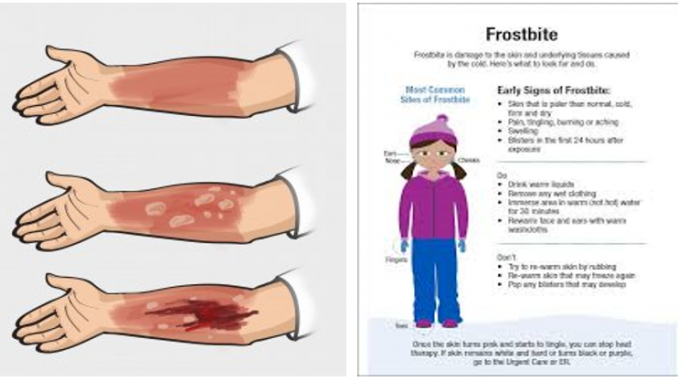
Table of Contents
BURNS
- Burn is a damage to the tissues or further body parts initiated by hazardous heat, fire, interaction with heated items, or substances.
Classification of a Percentage of Burns:
Burns are categorized as first, second, third, or fourth-degree burn depending on in what way, extremely and brutally they breach the skin’s exterior.
a) First-degree (superficial) burns:
- First-degree burns affect first the superficial cover of skin, the epidermis.
- In this degree of burn, the burn spot is sore, aching, dry, and with lack of blisters.
- Example of first-degree burn: Mild sunburn
- It heals without scarring within 5-10 days
b) Second-degree (partial thickness) burns:
- Second-degree burns include the burn of the epidermis and portion of the inferior cover of skin, the dermis.
- The burn spot appears red, blistered, and might be puffy and excruciating.
- Here, the pain is more severe
- Healing typically takes place within 3 weeks
c) Third-degree (full thickness) burns:
- Third-degree burns destroy the epidermis and dermis. Burns might enter into the deepest layer of skin, the subcutaneous tissue.
- The burn site may possibly appear white or darkened and burned.
- There is minimal or no pain due to decreased sensation.
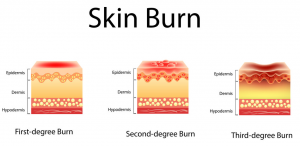
d) Fourth-degree burns:
- Fourth-degree burns undergo equally to the layers of the skin and underlying tissue as well as deeper tissue, probably encompassing muscle and bone.
- There is a lack of sensation in the area as the nerve endings are damaged.
How Can We Measure a Burn?
Burns in adults:
- Rule of 9’s is generally used to estimate burned area in an adult.
- The rule of nines calculation of the percentage of burns is effective to guide cure verdicts containing fluid artificial respiration and turn out to be a measure of the procedures to decide transference to a burn unit.
- Morbidity and mortality depend on the burned surface area. Sometimes, even small burns may be fatal in elderly population.

For simple understanding,
- Less than 10% burn in children and less than 15% burn in adults can be managed on own.
- However, burn in joints should be taken to the hospital.
More specifically,
- We can evaluate the body external part on an adult that has been burned by means of, multiples of nine.
- As an example, if both hands (18% x 2 = 36%), the groin (1%) and the front upper body and stomach were burned, this would include 55% of the human figure.
Burns in Children:
- It is necessary to understand than rule of 9’s method is too imprecise for estimating burned area in children.
- This is because the child’s head and lower extremities represent different proportions of surface area than in an adult.
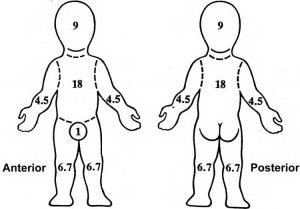
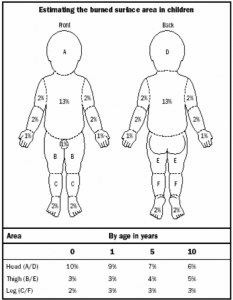
Serious Burn Requiring Hospitalization (According to World Health Organization):
- Greater than 15% burn in an adult
- Greater than 10% burn in a child
- Any burn in very young or elderly people
- Full thickness burn
- Burns of special regions: face, hands, feet, perineum
- Circumferential burns
- Inhalation injury
- Associated trauma or significant pre-burn illness e.g.: diabetes
First Aid Measures For Different Levels of Burns:
Step 1: Get away fast
- To avoid extra harm to the skin and underlying tissue, hurriedly move away from the sizzling water or fire—the less contact, the lesser the injury.
Step 2: Uncover the burnt skin
- Uncovering the burn is essential, as it provides you a superior chance to assess the kind and level of the burn.
- Take out any clothes covering them.
- In addition, taking away clothes covering the burn is important for the next phase.
Step 3: Cool the burn site
- Cool tap water is adequate to avoid additional damage to the tissue.
- Do not place ice on burns; as ice tempts to contraction of small blood vessels in the spot of the burn, which leads to ischemia and extra skin harm.
Step 4:
For 1st degree burn
If it appears alike 1st-degree burn, one with red skin but lack of blisters, that might be managed at home.
- By no means, do not tie up to this kind of burn.
- Rinse the skin with some antibacterial solution.
- Cover the burn with some pain releasing ointment comprising local anesthetic, e.g. 1% lidocaine.
- Take a single tablet of aspirin to lessen the ache.
- It would take 4-6 days to patch up fully.
Step 5:
For 2nd-degree burn
If any blisters are seen, it is possibly a 2nd-degree burn. Normally, after placing it underneath tap water and cleaning it with antiseptic solutions, perform the following.
- Local aching releasing ointment might be used.
- Certainly, do not interrupt the blisters (for panic of infection).
- Sterilized Vaseline gauze is used to cover the spot of the blister (never use cotton or classic gauze, as they can turn out to be adherent to the tissue, causing further damage when they get detached).
- Change the bandage every 1-2 days. However, formerly placing down the fresh bandage, mark sure to rinse the burn with water and antiseptic solution.
- Watch for any signal of infection that possibly will place over the place of burn, e.g. infection, unsolved escalations in pain at the spot of burn or any anomalous expulsion like pus.
Step 6:
For 3rd-degree burn
- Do not treat yourself. Look for medical responsiveness instantly.
FROSTBITES:
What are Frostbites?
- Frostbite is a damage to tissues or covering part of the body starts through freezing caused by the development of frost crystals in the interior cells, breaking the cells and that leads to cell damage.
- It is the injury due to exposure to cold especially in high altitude.
Pathology of Frostbite:
- Damage of the vessels
- Usually affects the fingers, toes and exposed extremities, ear, nose, chin etc.
Stages of Frostbite:
Stage 1: Superficial Frostbite
- The 1st degree of frostbite also identified as frostnip.
- This form of frostbite might seem as white, waxy, cold skin. Later after rewarming the affected part by warm water, the frostbitten area might seem like red and peel similar to a sunburn.

Stage 2: Partial-thickness Frostbite
- The 2nd degree of frostbite, which might be sensationless and sensed as rigid to the touch.
- The skin could even halt sunken once being poked.
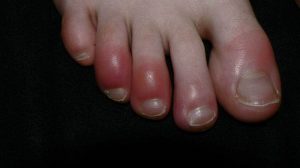
Stage 3: Full-thickness Frostbite
- This is the 3rd degree of frostbite and deliberated the most life-threatening incident.
- The skin tissue possibly will look as white and frozen solid, nevertheless will later pass away and turn black.

Clinical Features of Frostbite:
- Prickling pain
- Loose of sensation
- Skin discoloration
- Blistering
- Hardness
- Impaired movement
First aid Measures For Frostbite:
- Transport the victim’s indoors, away from the cold
- Take out all wet outfit and tightening clothing (such as socks, boots, and gloves), and switch with a dry outfit.
- Stop rubbing the affected region, as this will simply worsen the damage.
- Do not use dry warmness— for example, a fireplace, oven, or heating pad — to warm up frostbite.
- Do not break any blisters.
- Warm the frostbitten portions gradually in warm (not hot) water for approximately 30 minutes.
- Throughout the rewarming procedure, the pain could be life-threatening and oral or intravenous analgesics possibly will be a prerequisite.
- Place hygienic cotton balls among frostbitten fingers and toes after they have been warmed.
- Lightly wrap warmed parts with hygienic covers to avoid refreezing
- Warm clothing and hot drinks should be provided as it helps to return circulation
- Do not allow the victim to smoke as nicotine may cause peripheral vasoconstriction.
- In extreme cases or any danger signs, refer to the hospital.
References and For More Information:
https://www.who.int/surgery/publications/Burns_management.pdf
https://www.ncbi.nlm.nih.gov/books/NBK539773/
https://www.medicinenet.com/script/main/art.asp?articlekey=31816
https://www.medicinenet.com/script/main/art.asp?articlekey=3522
https://www.emedicinehealth.com/burn_percentage_in_adults_rule_of_nines/article_em.htm
https://www.urmc.rochester.edu/encyclopedia/content.aspx?ContentTypeID=90&ContentID=P09575
https://www.healthline.com/health/frostbite-stages
https://forefrontdermatology.com/frostbite-101/